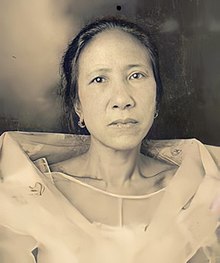Gregoria de Jesús
Gregoria de Jesús | |
|---|---|
 Portrait of Gregoria de Jesús | |
| Vice President of the Tagalog Republic | |
| In office August 24, 1896 – March 22, 1897 | |
| Preceded by | Post established |
| Succeeded by | None |
| Personal details | |
| Born | Gregoria de Jesús y Álvarez May 9, 1875 Caloocan, Manila, Captaincy General of the Philippines, Spanish Empire |
| Died | March 15, 1943 (aged 67) Manila, Philippine Commonwealth |
| Resting place | Manila North Cemetery, Manila, Philippines |
| Political party | Katipunan |
| Spouses | |
| Children | 7 (including Juan Nakpil) |
| Occupation | Housewife, politician |
Gregoria de Jesús y Álvarez (May 9, 1875 – March 15, 1943), also known by her nickname Oriang,
Early life
Gregoria de Jesús was born in the town of
First marriage and the Philippine Revolution
When De Jesús was only 18 years old, Andrés Bonifacio fell in love with her and wanted to marry her.
Before they got married in March 1893, she joined the Katipunan adopting the name Lakambini (
A year later, she returned to her family's house because she was
On August 19, 1896, the Katipunan was exposed by Teodoro Patino, a disgruntled member.
On April 28, 1897, De Jesús, Bonifacio, along with his brother
The brothers were found guilty and sentenced to death on charges that included
Later life and death
Julio Nakpil, a commander of the Katipunan forces in northern Philippines loyal to Bonifacio, took care of the widowed De Jesús. The two fell in love, and were married at
De Jesús later died in 1943 during the
In popular culture
- Portrayed by Lovely Rivero in the 1996 TV series, Bayani.
- Portrayed by Danielle Castaño in the 2010 film, Ang Paglilitis ni Andres Bonifacio.
- Portrayed by Sunshine Cruz in the 2012 film, El Presidente.
- Portrayed by Nica Naval in the 2012 film, Supremo.
- Portrayed by Glaiza de Castro in the 2013 TV series, Katipunan and 2014 TV series Ilustrado.
- Portrayed by Vina Morales in the 2014 film, Bonifacio: Ang Unang Pangulo.
- Portrayed by Kris Bernal in the 2017 docufilm, The Lakambini of the Katipunan.
Site Link
- GREGORIA DE JESUS (in English)
- Gregoria de Jesus:Lakambini of the Katipunan (in English)
- National Heroes of the Philippines
- Solidarity Philippines Australia Network Retrieved 2006-12-28. (in English)
References
- ^ a b c d e "Excerpt". Archived from the original on April 27, 2006. Santiago, Lilia Quindoza (1997). Tales of Courage & Compassion: Stories of Women in the Philippine Revolution. HASIK inc.
- ^ Jesus, Gregoria de. "Filipino Women". Solidarity Philippines Australia Network. Retrieved December 28, 2006.
- ^ a b c d e f g h Jesus, Gregoria de. "The Katipunera (autobiography)". Filipinas Heritage Library. Archived from the original on June 22, 2006. Retrieved December 28, 2006.
- ^ ISBN 978-971-630-005-5.
- ISBN 9789715422154. Archivedfrom the original on November 28, 2020. Retrieved August 19, 2019.
- ^ Ocampo, Ambeth R. "Walking tour of Bonifacio's Manila". opinion.inquirer.net. Archived from the original on August 19, 2019. Retrieved August 19, 2019.
- ^ Lizares, Luci (December 1, 2016). "Andres Bonifacio: beyond the textbooks". Sunstar. Archived from the original on August 19, 2019. Retrieved August 19, 2019.
- ISBN 978-971-23-5045-0.
- ISBN 971-27-0920-5.
- ^ "Ariston Bautista Y Lin – Bahay Nakpil-Bautista". Retrieved April 27, 2022.
- ^ "The Katipunera (autobiography)". MSC. Retrieved December 28, 2006.
